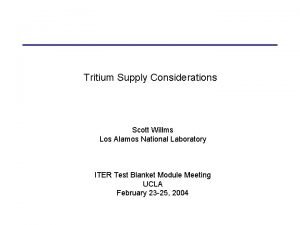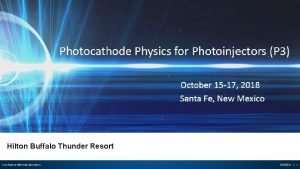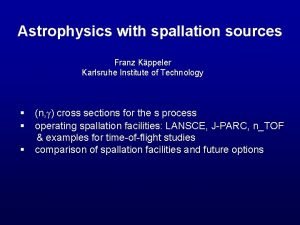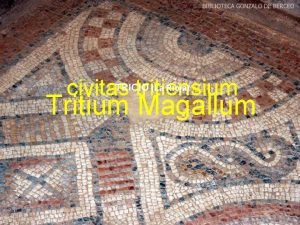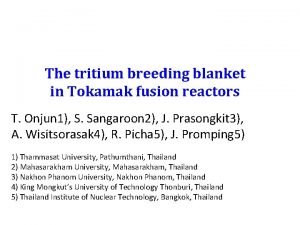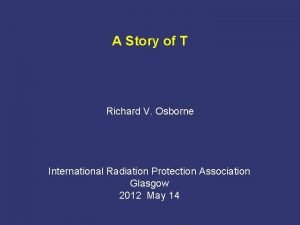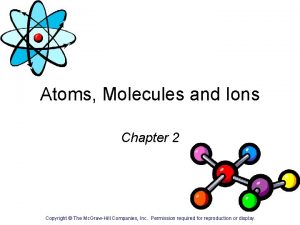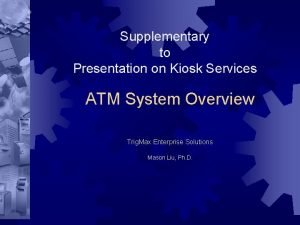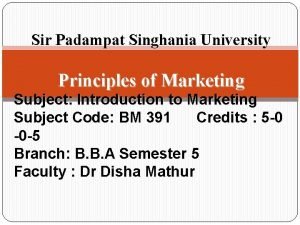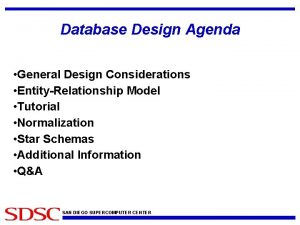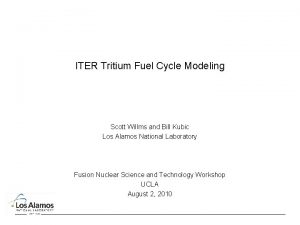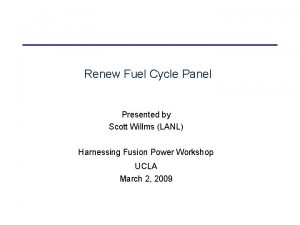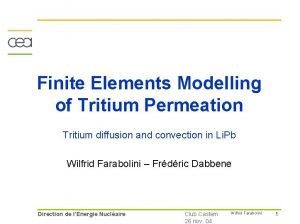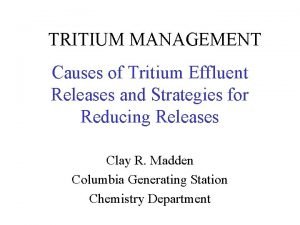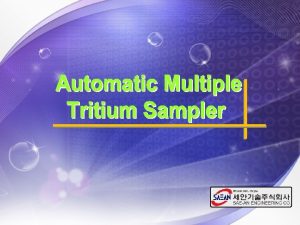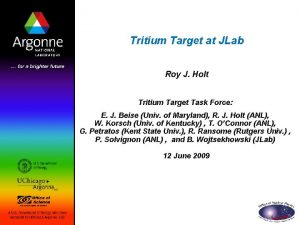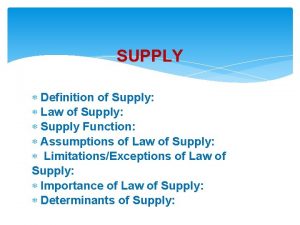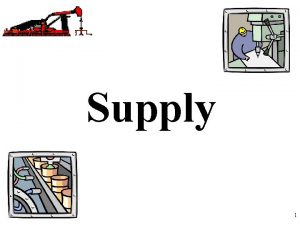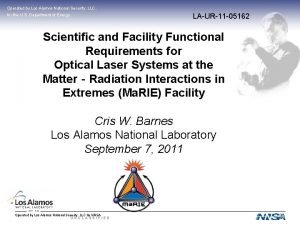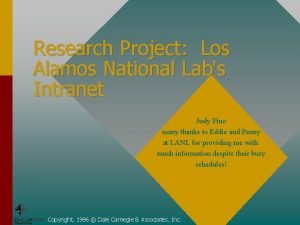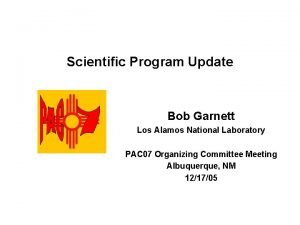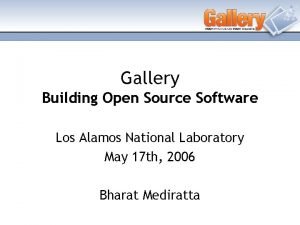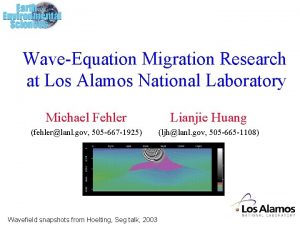Tritium Supply Considerations Scott Willms Los Alamos National

















- Slides: 17

Tritium Supply Considerations Scott Willms Los Alamos National Laboratory ITER Test Blanket Module Meeting UCLA February 23 -25, 2004

Credits • Contributors – P. Rutherford, D. -K. Sze, J. Anderson, M. Abdou • References – Rutherford, P. , “The Tritium Window”, informal report (1999). – Bergeron, K. D. , Tritium on Ice, MIT Press (2002). – Wittenberg, L. J. , “Comparison of Tritium Production Reactors”, Fusion Tech. , 19, 1040 (1991). – Snowmass 1999 report – Snowmass 2002 report – Personal Communication, Ontario Power Generation (2003). – Personal Communication, Atomic Energy Canada (2003). – Personal Communication, Accelerator Production of Tritium (1999). – Inspector General Report, “Modernization of Tritium Requirements Systems”, 12/03

How “open” is the tritium window? Tritium used - tritium bred + tritium for next step < tritium available • Tritium used: 55. 8 Kg T/yr for 1000 MWfus (includes alpha heat), 100% available • Tritium bred: Fusion has never done this • Tritium for next step: – ITER startup inventory estimated to be ~3 Kg – DEMO startup inventory likely to be between 4 -10 Kg • Tritium available: 18. 5 Kg (2003)

Brief history of US tritium production • 1953 -1955 Tritium producing reactors online • 1976 -1988 Need for new tritium production method recognized, many false starts, controversy, no real progress • 1979 Three Mile Island • 1986 Chernobyl • 1987 N and C reactors shutdown • 1988 K, L and P shutdown • 1989 Plan to refurbish/restart K New Production Reactor project start -MHTGR, HWR, LWR • 1990 Ebasco HWR and MHTGR selected • 1991 Arms reduction progress, only one option needed K Reactor leaks

Brief history of US tritium production (cont. ) 1992 $1. 5 B spent on K reactor $1. 5 B spent on NPR, program cancelled 1993 K reactor restart cancelled 1995 APT primary option and CLWR is backup 1997 TVA proposed sale of Bellefonte to DOE with Watts Bar/Sequoya service as backup 1998 “Interagency review” issued Watts Bar service chosen 2011 Production restart date for START-II 2029 Von Hippel estimate for real restart date

Cost of tritium • • Old DOE price was $10 K/gm Present Canada price is ~$30 K/gm Expected cost for future US production has been: $100 K to $200 K/gm DOE Inspector General report (12/2003) states that the DOE needs to accurately assess tritium needs and states: – “Tritium costs in the range $84, 000 to $130, 000 per gram, depending on actual production requirement, and excess tritium would simply decay without being used. ” – This assumes that a light water reactor is used for production – Thus, $100 K/gm appears to be a good value • • • 4 kg startup cost at $30, 000/gm: $120 M 4 kg startup cost at $100, 000/gm: $400 M 1 kg/yr operation--$30 M/yr vs. $100 M/yr

Cost estimates for US tritium production from July 1998 Review (in $B)

Canadian CANDU reactor summary • 22 CANDU reactors in Canada • 8 were taken out of service between ‘ 95 and ‘ 98 • 6 of these will be back in service by end of 2003 • Average of reactors is 20. 8 years

Non-Canadian CANDU reactor summary • 12 reactors: Argentina (1), India (2), S. Korea (4), Pakistan (1), Romania (2), China (2)

Presently the only credible tritium for D-T fusion development is available from OPG • Presently there are 20 operating Canadian CANDU reactors • Reactors licensed for 40 years • Tritium is recovered from these reactors at the Tritium Recovery Facility (Darlington) • Presently about 19 Kg tritium on hand • Tritium recovery rate was ~2. 1 Kg/yr. Now it is ~1. 5 Kg/yr. • It is assumed that the tritium recovery rate will remain at this level until 2025. Thereafter the tritium recovery rate will decrease rapidly • Tritium sales: About 0. 1 Kg/yr • Tritium decay rate: 5. 47 %/yr

Assumptions • Did not assume – CANDU lifetime extended from 40 to 70 years – More CANDU’s built – Li targets irradiated in commercial reactors (including CANDU’s) to specifically breed fusion tritium – Tritium procured from “nuclear superpowers” • Also did not assume – Other major customers for Canadian tritium – CANDU’s idled/decommissioned early – Canadian tritium unavailable for political reasons (note Canada now withdrawn from ITER) – Canadian tritium is not simply sent to waste – CANDU tritium production rate is lower than expected

Projected Canadian tritium inventory without major impact from fusion. Curve includes CANDU generation assumptions and 100 gm sold/yr.

Baseline ITER Final Design Report experimental program would have consumed more than the available tritium

The reduced size and reduced mission machine, ITERFEAT, will have a smaller impact on tritium supply

Tritium price impact on ITER-FEAT

A wide range of fusion impacts on tritium supply can result for various scenarios

Conclusions • Tritium available for fusion development will likely begin to diminish rapidly during the next 35 years • Fusion should be developed expeditiously to take advantage of this unique opportunity • Development of D-T fusion must be carefully planned world-wide taking into account available tritium – Experiments without breeding must be low power and/or low availability (ITER-FEAT appears okay. . . but barely so) – Sufficient tritium must be left for next steps – Significant losses of tritium must be carefully avoided • Development and deployment of program components which breed significant quantities of tritium are needed soon
 Tritium
Tritium Alla en las tierras altas antonio machado
Alla en las tierras altas antonio machado Sondheim
Sondheim Los alamos resorts
Los alamos resorts Lansce los alamos
Lansce los alamos David willms
David willms Tritium magallum
Tritium magallum Tritium
Tritium Tritium half life
Tritium half life Protium deuterium tritium
Protium deuterium tritium What are the general considerations in machine design?
What are the general considerations in machine design? Tax considerations for setting up a new business
Tax considerations for setting up a new business Atm kiosk solution
Atm kiosk solution Exchange transaction and relationship in marketing
Exchange transaction and relationship in marketing Mechanical design of transmission line
Mechanical design of transmission line Database design considerations
Database design considerations Psychomotor considerations language acquisition
Psychomotor considerations language acquisition What is cloud delivery model
What is cloud delivery model
